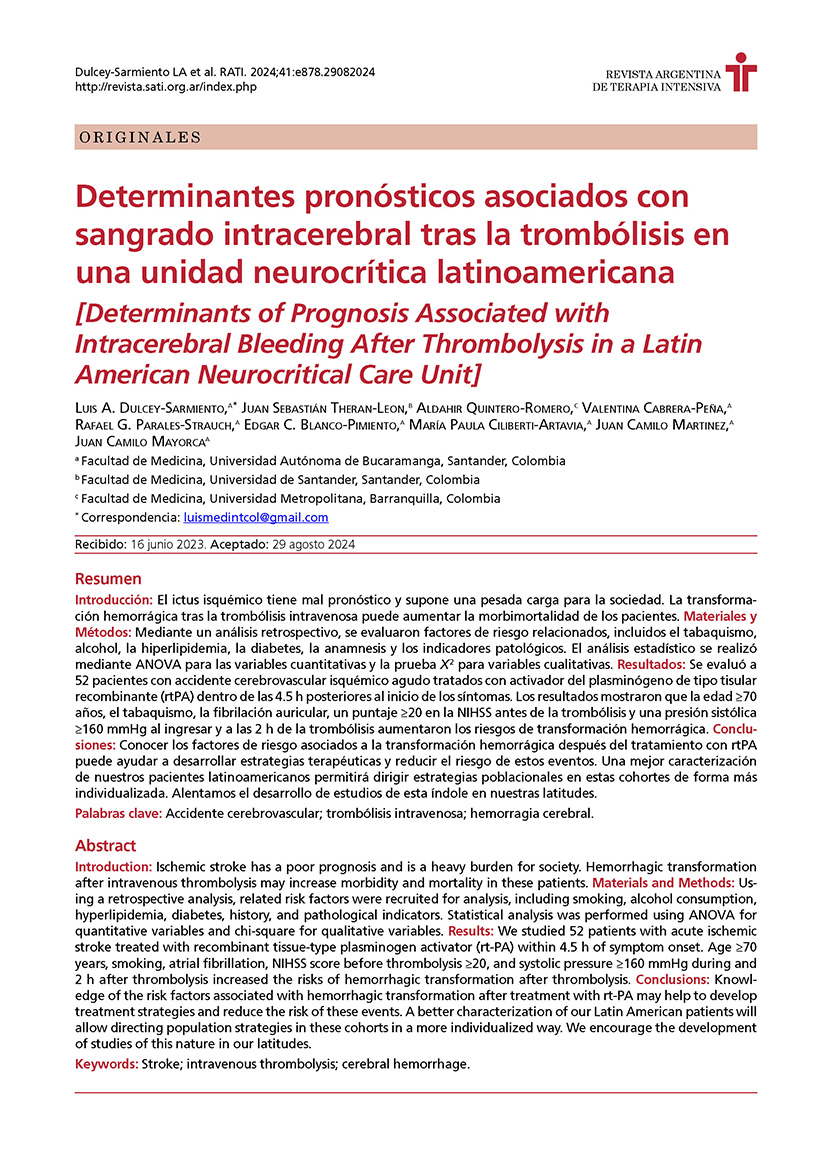Determinants of Prognosis Associated with Intracerebral Bleeding After Thrombolysis in a Latin American Neurocritical Care Unit
Main Article Content
Abstract
Introduction: Ischemic stroke has a poor prognosis and is a heavy burden for society. Hemorrhagic transformation after intravenous thrombolysis may increase morbidity and mortality in these patients. Materials and Methods: Using a retrospective analysis, related risk factors were recruited for analysis, including smoking, alcohol consumption, hyperlipidemia, diabetes, history, and pathological indicators. Statistical analysis was performed using ANOVA for quantitative variables and chi-square for qualitative variables. Results: We studied 52 patients with acute ischemic stroke treated with recombinant tissue-type plasminogen activator (rt-PA) within 4.5 h of symptom onset. Age ≥70 years, smoking, atrial fibrillation, NIHSS score before thrombolysis ≥20, and systolic pressure ≥160 mmHg during and 2 h after thrombolysis increased the risks of hemorrhagic transformation after thrombolysis. Conclusions: Knowledge of the risk factors associated with hemorrhagic transformation after treatment with rt-PA may help to develop treatment strategies and reduce the risk of these events. A better characterization of our Latin American patients will allow directing population strategies in these cohorts in a more individualized way. We encourage the development of studies of this nature in our lat
Article Details

This work is licensed under a Creative Commons Attribution 4.0 International License.
The magazine does not retain the reproduction rights (copyright) so the authors can republish their works with the sole mention of the original publication source.
References
Modrego PJ. The risk of symptomatic intracranial hemorrhage after thrombolysis for acute stroke: Current concepts and perspectives. Ann Indian Acad Neurol [Internet]. 2019;22(3):336–40. Disponible en: http://dx.doi.org/10.4103/aian.AIAN_323_18
Charbonnier G, Bonnet L, Biondi A, Moulin T. Intracranial bleeding after reperfusion therapy in acute ischemic stroke. Front Neurol [Internet]. 2020;11:629920. Disponible en: http://dx.doi.org/10.3389/fneur.2020.629920
Tsivgoulis G, Kargiotis O, De Marchis G, Kohrmann M, Sandset EC, Karapanayiotides T, et al. Off-label use of intravenous thrombolysis for acute ischemic stroke: a critical appraisal of randomized and real-world evidence. Ther Adv Neurol Disord [Internet]. 2021;14:1756286421997368. Disponible en: http://dx.doi.org/10.1177/1756286421997368
Berge E, Whiteley W, Audebert H, De Marchis GM, Fonseca AC, Padiglioni C, et al. European Stroke Organisation (ESO) guidelines on intravenous thrombolysis for acute ischaemic stroke. Eur Stroke J [Internet]. 2021;6(1):I–LXII. Disponible en: http://dx.doi.org/10.1177/2396987321989865
Toyoda K, Koga M, Iguchi Y, Itabashi R, Inoue M, Okada Y, et al. Guidelines for intravenous thrombolysis (recombinant tissue-type plasminogen activator), the third edition, march 2019: A guideline from the japan stroke society. Neurol Med Chir (Tokyo) [Internet]. 2019;59(12):449–91. Disponible en: http://dx.doi.org/10.2176/nmc.st.2019-0177
Alamowitch S, Turc G, Palaiodimou L, Bivard A, Cameron A, De Marchis GM, et al. European Stroke Organisation (ESO) expedited recommendation on tenecteplase for acute ischaemic stroke. Eur Stroke J [Internet]. 2023;8(1):8–54. Disponible en: http://dx.doi.org/10.1177/23969873221150022
Han TS, Gulli G, Fry CH, Affley B, Robin J, Fluck D, et al. Adverse consequences of immediate thrombolysis-related complications: a multi-centre registry-based cohort study of acute stroke. J Thromb Thrombolysis [Internet]. 2022;53(1):218–27. Disponible en: http://dx.doi.org/10.1007/s11239-021-02523-2
Botelho A, Rios J, Fidalgo AP, Ferreira E, Nzwalo H. Organizational factors determining access to reperfusion therapies in ischemic stroke-systematic literature review. Int J Environ Res Public Health [Internet]. 2022;19(23). Disponible en: http://dx.doi.org/10.3390/ijerph192316357
Lin S-F, Chen C-F, Hu H-H, Ho B-L, Chen C-H, Chan L, et al. Comparison of different dosages of alteplase in atrial fibrillation-related acute ischemic stroke after intravenous thrombolysis: A nationwide, multicenter, prospective cohort study in Taiwan. J Am Heart Assoc [Internet]. 2022;11(3):e023032. Disponible en: http://dx.doi.org/10.1161/JAHA.121.023032
Bagoly Z, Szegedi I, Kálmándi R, Tóth NK, Csiba L. Markers of coagulation and fibrinolysis predicting the outcome of acute ischemic stroke thrombolysis treatment: A review of the literature. Front Neurol [Internet]. 2019;10:513. Disponible en: http://dx.doi.org/10.3389/fneur.2019.00513
Zhou Y, Yan S, Song X, Gong Y, Li W, Wang M, et al. Intravenous thrombolytic therapy for acute ischemic stroke in Hubei, China: a survey of thrombolysis rate and barriers. BMC Neurol [Internet]. 2019;19(1):202. Disponible en: http://dx.doi.org/10.1186/s12883-019-1418-z
Evans, N. R., Sibson, L., Day, D. J., Agarwal, S., Shekhar, R., & Warburton, E. A. (2022). Hyperacute stroke thrombolysis via telemedicine: a multicentre study of performance, safety and clinical efficacy. BMJ open, 12(1), e057372. https://doi.org/10.1136/bmjopen-2021-057372
Ng SH-X, Wong AWK, Chen CH, Tan CS, Müller-Riemenschneider F, Chan BPL, et al. Stroke factors associated with thrombolysis use in hospitals in Singapore and US: A cross-registry comparative study. Cerebrovasc Dis [Internet]. 2019;47(5–6):291–8. Disponible en: http://dx.doi.org/10.1159/000502278
Herath, H. M. M. T. B., Rodrigo, C., Alahakoon, A. M. B. D., Ambawatte, S. B., Senanayake, S., Senanayake, B., & Fernando, A. (2021). Outcomes of stroke patients undergoing thrombolysis in Sri Lanka; an observational prospective study from a low-middle income country. BMC neurology, 21(1), 434. https://doi.org/10.1186/s12883-021-02475-3
Nordanstig A, Curtze S, Gensicke H, Zinkstok SM, Erdur H, Karlsson C, et al. EndoVAscular treatment and ThRombolysis for Ischemic Stroke Patients (EVA-TRISP) registry: basis and methodology of a pan-European prospective ischaemic stroke revascularisation treatment registry. BMJ Open [Internet]. 2021;11(8):e042211. Disponible en: http://dx.doi.org/10.1136/bmjopen-2020-042211
Koga M, Yamamoto H, Inoue M, Asakura K, Aoki J, Hamasaki T, et al. Thrombolysis with alteplase at 0.6 mg/kg for stroke with unknown time of onset: A randomized controlled trial: A randomized controlled trial. Stroke [Internet]. 2020;51(5):1530–8. Disponible en: http://dx.doi.org/10.1161/STROKEAHA.119.028127
Fu Q, Wang X, Zhang D, Shi L, Wang W, Guo Z, et al. Improving thrombolysis for acute ischemic stroke: The implementation and evaluation of a theory-based resource integration project in China. Int J Integr Care [Internet]. 2022;22(1):9. Disponible en: http://dx.doi.org/10.5334/ijic.5616

